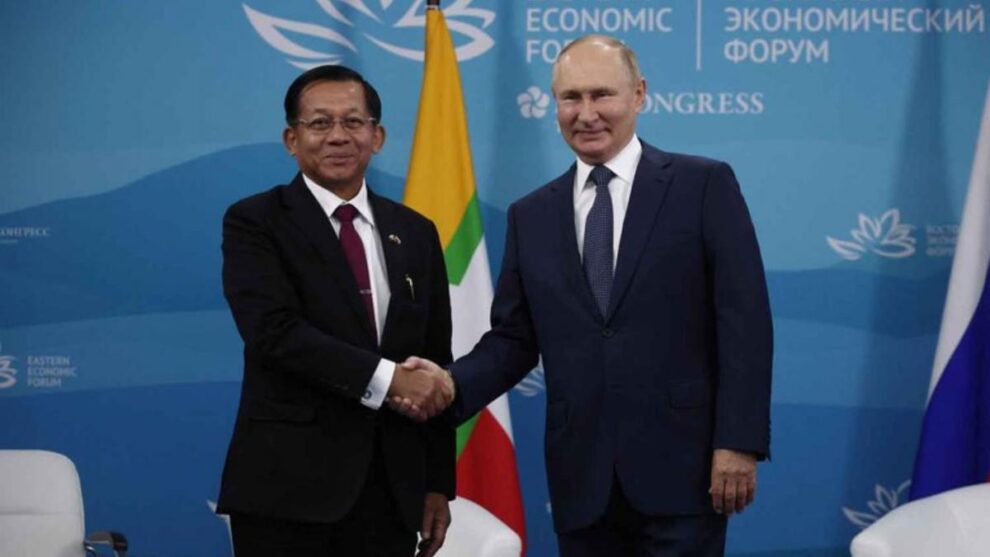Timing is almost everything in diplomacy in the pursuit of foreign policy strategies. The foreign office consultations during the past fortnight that India hosted with two of its crucially important neighbouring countries Bangladesh and Myanmar constitute a significant signpost. In the volatile international environment, they throw light on where India’s strategic interests lie.
India’s relations with Bangladesh and Myanmar may appear to be like chalk and cheese but similarities are not lacking. If the leitmotif in the relations with Bangladesh lies in development, trade and connectivity — and of course, deep-rooted social and cultural values — when it comes to Myanmar, the locus lies in India’s vital national security interests and connectivity.
Both countries impact the security and stability of India’s northeast region whose integration is still a work in progress after 75 years of independence. Equally, Myanmar and Bangladesh are buffeted by big power rivalries whose outcome will have far-reaching implications in the geopolitics of the region. The stance of the US, which is on the one hand meddling in the election process in Bangladesh and is covertly backing a regime change in Myanmar on the other hand, puts India on the same page as China and Russia.
Succinctly put, a defeat of the Sheikh Hasina government in the January 7 election in Bangladesh or the ascendance of fissiparous tendencies challenging the unity and integrity of Myanmar will have deleterious consequences for India. Notably, the foreign office consultations with Bangladesh (November 24) took place when that country is due to go for election, whereas, the consultations with Myanmar (December 6) were scheduled at all, notwithstanding the apocalyptic predictions of the collapse of the Myanmar military at the hands of insurgent ethnic groups and ‘pro-democracy’ militants backed by the Five Eyes.
The consultations with Myanmar implied at the very least that India does not share the scare-mongering by the Five Eyes that “The junta could be staring at defeat should the rebel push continue.” In fact, the one message coming out of the Indian readout is that it is business as usual between New Delhi and Myanmar’s capital Naypyidaw, with the “situation along the border and security” being the top priority.
Interestingly, on the eve of the foreign office consultations, a high-level inter-ministerial delegation led by the Russian Security Council Secretary Nikolay Patrushev visited Myanmar. The Tass news agency reported that the talks covered “cooperation between law enforcement agencies, special services and defence ministries, with a focus on ensuring law and order and the rule of law, counterterrorism measures, and analysis of channels and sources of financing for terrorist organisations.”
The Security Councils of Russia and Myanmar signed a memorandum of cooperation during Patrushev’s visit. A statement from Moscow said that “At the end of Russian-Myanmarese security consultations, a memorandum of cooperation between the security councils was signed. It confirmed the readiness for diversified cooperation between the security agencies of Russia and Myanmar, as well as for regular consultations and exchanges of views on issues of national, regional and international security.”
The statement highlighted that officials from Russia’s Defense Ministry, Federal Security Service (FSB) and representatives from the ministries of economic development, industry and trade, energy and agriculture were represented in Patrushev’s delegation. Patrushev, Kremlin’s topmost security official, was received by General Min Aung Hlaing, chairman of the State Administration Council. (During the period since the military takeover in February 2021, General Min Aung Hlaing has visited Moscow thrice.)
Last month, Myanmar and Russia held a 3-day joint naval exercise, the first of its kind. Russian anti-submarine vessels Admiral Tributs and Admiral Panteleev arrived at the port of Thilawa near Yangon ahead of the drills. The exercise in the Bay of Bengal aroused much attention regionally and internationally.
Notably, Voice of America in a commentary said, “Analysts say India is not averse to Russia, its old ally and largest supplier of defence equipment, stepping up its presence in its maritime neighbourhood despite New Delhi’s deepening partnership with the United States, Japan and Australia to counter China’s expanding footprint in the strategic waters. Ignoring pressure from its Western partners, New Delhi has maintained its decades-long relationship with Moscow and taken a neutral stand on the war in Ukraine.”
The naval exercise was scheduled during the visit to Naypyidaw by Russian Navy chief Admiral Nikolai Yevmenov, who is, interestingly, a graduate of Lenin Komsomol Higher Naval School of Submarine Navigation and had served almost entirely in the nuclear submarine formations of Russia’s Pacific Fleet. General Min Aung Hlaing received the admiral.
Clearly, Russia is returning to Myanmar in a big way. On Thursday, US government-funded Radio Free Asia, which is promoting the insurgent groups in Myanmar, featured an extraordinarily commentary on the deepening Russia-Myanmar ties, entitled Pariahs in arms: Russia finds an ally in military-run Myanmar which traces the long history of the Soviet Union’s relations with Myanmar. Washington is furious that Russia has appeared on the scene as ‘spoiler’ just when the Five Eyes’ regime change project in Myanmar is showing some spunk.
The western strategy is to somehow open a pathway to get the Myanmar military to agree to some sort of power sharing arrangement with the Five Eyes proxies. But why would the military walk into such a trap when Russia is offering help?
Clearly, there is a Russian-Indian convergence with regard to Myanmar situation. Moscow and Delhi do not lend credence to the Five Eyes project to overthrow General Min Aung Hlaing. They are not only dealing with the powers that be in Myanmar but also promoting bilateral cooperation. They sense that the Five Eyes project is to draw the curtain on the Aung San Suu Kyi era and laterally insert pro-western elements into some power-sharing arrangement that would potentially tilt the geopolitics of the Bay of Bengal.
Indeed, Suu Kyi turned out to be her father’s daughter — a staunch Burman nationalist who wouldn’t barter away her country’s sovereignty and independence. The same is the case with Sheikh Hasina. The crux of the matter is that the US never tolerates nationalist regimes pursuing independent foreign policies.
If the West’s project in Myanmar and Bangladesh succeeds, the consequences will be very serious for the littoral states of the Bay of Bengal. India’s current difficulties with Canada and the US will look a picnic in comparison. Take, for instance, the discourses over the aborted killing of Pannun.
On the one hand, some voices are singing lullabies, lulling us into complacency that the US and India are “dating” and, having recently “moved in together,” it is only to be expected that the two partners with “different habits” are simply trying to figure out “where does this go?” On the other hand, voices linked to the US security establishment have come tantalisingly close to making insinuations that the alleged Indian involvement in the attempt on the Khalistani propagandists’s life could be reflective of a shift in Indian statecraft .
Russia understands the stakes involved in the geopolitics of Bay of Bengal and is clear in its mind as to where its interests lie in the co-relation of forces, while pushing back the US pressure on both Bangladesh and Myanmar. Against such a complex strategic backdrop, the resumption of the annual Russian-Indian summit has become a strategic necessity. Its punctuation fills the region’s geopolitics with a silent intonation. Don’t we live in a fantasy world — a world of illusion? The great task of diplomacy is to find reality.
M. K. Bhadrakumar was a career diplomat by profession. Roughly half of the 3 decades of his diplomatic career was devoted to assignments on the territories of the former Soviet Union and to Pakistan, Iran and Afghanistan. Other overseas postings included South Korea, Sri Lanka, Germany, and Turkey. He writes mainly on Indian foreign policy and the affairs of the Middle East, Eurasia, Central Asia, South Asia and the Asia-Pacific.

































